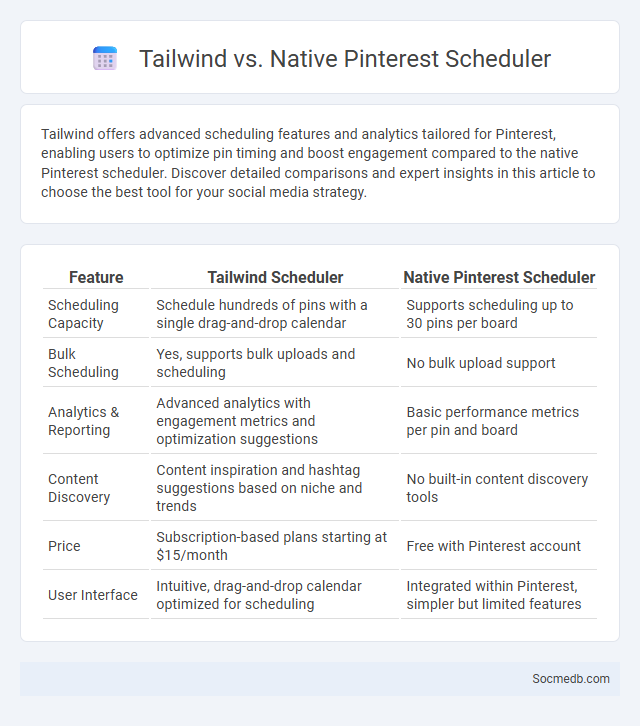
Photo illustration: Tailwind vs native Pinterest scheduler
Tailwind offers advanced scheduling features and analytics tailored for Pinterest, enabling users to optimize pin timing and boost engagement compared to the native Pinterest scheduler. Discover detailed comparisons and expert insights in this article to choose the best tool for your social media strategy.
Table of Comparison
| Feature | Tailwind Scheduler | Native Pinterest Scheduler |
|---|---|---|
| Scheduling Capacity | Schedule hundreds of pins with a single drag-and-drop calendar | Supports scheduling up to 30 pins per board |
| Bulk Scheduling | Yes, supports bulk uploads and scheduling | No bulk upload support |
| Analytics & Reporting | Advanced analytics with engagement metrics and optimization suggestions | Basic performance metrics per pin and board |
| Content Discovery | Content inspiration and hashtag suggestions based on niche and trends | No built-in content discovery tools |
| Price | Subscription-based plans starting at $15/month | Free with Pinterest account |
| User Interface | Intuitive, drag-and-drop calendar optimized for scheduling | Integrated within Pinterest, simpler but limited features |
Overview: Pinterest Marketing Tools
Pinterest marketing tools offer powerful features to enhance your brand's visual storytelling and drive targeted traffic. These tools include Pinterest Analytics for tracking engagement metrics, the Pinterest Tag for conversion tracking, and promoted pins to amplify content reach. Using these tools effectively boosts your campaign performance and optimizes audience targeting on the platform.
Key Features: Tailwind vs Native Pinterest Scheduler
Tailwind offers advanced scheduling features for Pinterest, such as SmartLoop, which automates pin resharing to increase engagement and reach. Its dashboard provides in-depth analytics and hashtag suggestions tailored to maximize pin performance, unlike the native Pinterest scheduler's basic scheduling capabilities. Tailwind's bulk upload and calendar visualization tools enhance workflow efficiency, making it a preferred choice for marketers managing multiple boards or accounts.
Scheduling Workflow Differences
Social media scheduling workflows vary significantly based on platform algorithms and user engagement patterns, affecting how content is timed and published. Tools like Hootsuite and Buffer offer automated posting features tailored to optimize your content reach and maintain consistent brand presence. Understanding these differences in scheduling can enhance Your efficiency and improve overall campaign performance.
Content Planning Capabilities
Effective content planning capabilities for social media involve scheduling posts strategically to maximize engagement and reach. Utilizing analytics tools enables precise audience targeting and content optimization based on performance data. Integrating multimedia assets like images and videos enhances user interaction and brand visibility across platforms.
Analytics and Reporting Comparison
Understanding social media analytics and reporting enables your business to track user engagement, measure campaign effectiveness, and optimize content strategies based on data-driven insights. Tools like Facebook Insights, Twitter Analytics, and Instagram Insights offer specialized metrics tailored to different platforms, allowing for comprehensive comparison and performance evaluation. Leveraging these analytics empowers you to make informed decisions that enhance your social media presence and ROI.
Automation and Smart Scheduling
Automation in social media streamlines content posting by using AI-driven tools to analyze engagement patterns and optimize timing for maximum reach. Smart scheduling software leverages algorithms to prioritize your posts during peak activity hours, ensuring consistent audience interaction and enhanced brand visibility. By integrating these technologies, you can maximize efficiency and maintain a strategic online presence without constant manual management.
Collaboration and Team Management
Effective collaboration and team management on social media platforms enhance real-time communication, streamline project workflows, and boost productivity through shared content calendars and task management tools. Utilizing integrated features like group chats, file sharing, and collaborative editing fosters transparency and accountability within teams. Social media analytics provide valuable insights to track engagement metrics and optimize strategies for better team performance.
Pricing and Value for Money
Social media platforms offer a range of pricing models, from free access supported by advertising to premium subscriptions with advanced features tailored for businesses and influencers. The value for money depends on user goals, with affordable plans providing essential tools for content creation, audience engagement, and analytics. Investing in paid options often yields higher returns through enhanced visibility, targeted advertising, and detailed performance insights.
User Experience and Interface
Optimizing social media platforms for superior User Experience (UX) and Interface (UI) design enhances engagement and retention by providing seamless navigation and intuitive layouts. Effective use of responsive design, clear visual hierarchy, and interactive elements ensures that Your interactions remain fluid across devices and screen sizes. Prioritizing accessibility and personalization in UI components boosts satisfaction and loyalty among diverse user demographics.
Which Scheduler is Best for You?
Choosing the best social media scheduler depends on your specific needs such as platform compatibility, user interface, and analytics features. Tools like Hootsuite offer comprehensive multi-platform management, while Buffer provides streamlined scheduling with insightful engagement metrics. Assessing your content strategy, posting frequency, and budget helps determine which scheduler aligns best with Your goals for efficient social media management.
 socmedb.com
socmedb.com